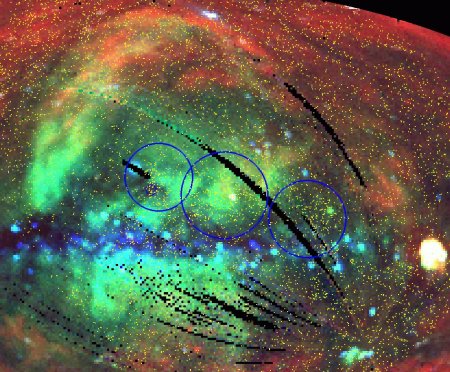Scorpius-Centaurus Association

Wide field X-ray image of the Scorpius-Centaurus association constructed from the data of the ROSAT All Sky Survey Background maps. The yellow dots mark the positions of bright X-ray sources detected in the survey (only about 10% of the brightest X-ray sources are shown). The blue circles mark the three subgroups Upper Scorpius, Upper Centaurus-Lupus, and Lower Centaurus-Crux (from left to right).
The Scorpius-Centaurus (Sco-Cen) Association is the nearest OB association to the Sun. It is centered about 470 light-years away in the Gould Belt and contains several hundred stars, mostly of type B, including Shaula, Lesath, and Antares. Though born roughly at the same time, the association's stars are not gravitationally bound, and the association is rapidly expanding.
Subcomponents of the Scorpius-Centaurus Association include the Upper Scorpius (the youngest), Upper Centaurus-Lupus (the oldest), and Lower Centaurus-Crux associations. The star formation process in Scorpius-Centaurus started in the Upper Centaurus-Lupus Association some 15 million years ago. About 12 million years ago the most massive star in Upper Centaurus-Lupus went supernova, creating a large shock wave. This shock wave passed through the Upper Scorpius cloud about 5 million years ago, and triggered the star formation process there. Shortly after, the strong winds of the numerous massive stars in Upper Scorpius started to disperse the molecular cloud and halted the star formation process. About 1.5 million years ago the most massive star in Upper Scorpius exploded as a supernova. This shock wave fully dispersed the Upper Scorpius molecular cloud and now passes through the Rho Ophiuchi Nebula, where it might well have started the star formation process about 1 million years ago. The superbubble known as Loop I, generated by supernovae around the Association is impinging on our own Local Bubble and directly affecting the environment in the solar neighborhood.


